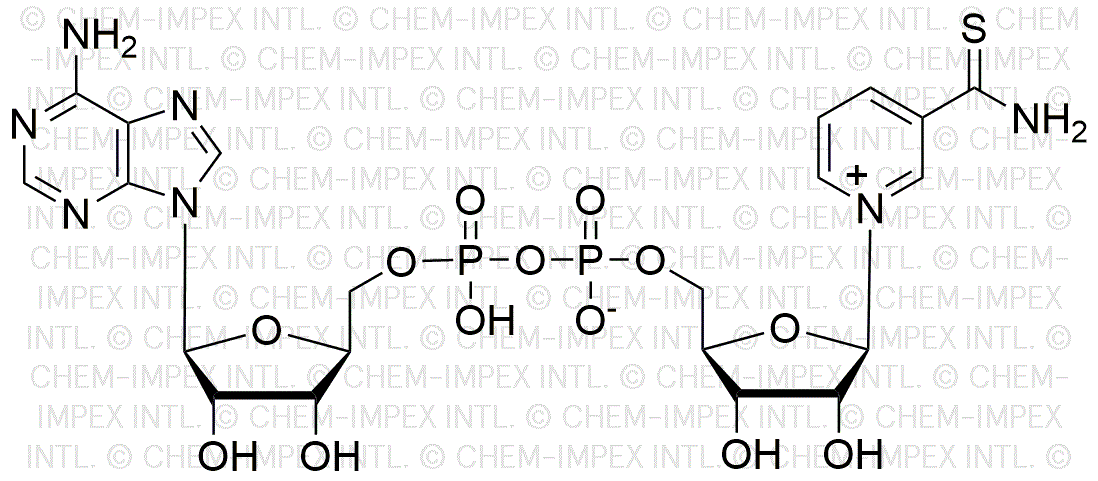Thionicotinamide adenine dinucleotide oxidized form is widely utilized in research focused on:
- Biochemical Pathway Studies: This compound is essential for studying metabolic pathways, particularly in cellular respiration and energy transfer, allowing researchers to understand how cells produce energy.
- Enzyme Activity Assays: It serves as a cofactor in various enzymatic reactions, making it invaluable for assays that measure enzyme kinetics and activity, especially in the fields of biochemistry and molecular biology.
- Drug Development: In pharmaceutical research, it aids in the development of new drugs targeting metabolic disorders by providing insights into the mechanisms of action of potential therapeutic agents.
- Cell Signaling Research: The compound plays a role in cell signaling pathways, helping researchers investigate how cells communicate and respond to external stimuli, which is crucial for understanding diseases like cancer.
- Antioxidant Studies: It is used in research focused on oxidative stress, allowing scientists to explore its potential protective effects against cellular damage, which is relevant in aging and neurodegenerative diseases.
General Information
Properties
Safety and Regulations
Applications
Thionicotinamide adenine dinucleotide oxidized form is widely utilized in research focused on:
- Biochemical Pathway Studies: This compound is essential for studying metabolic pathways, particularly in cellular respiration and energy transfer, allowing researchers to understand how cells produce energy.
- Enzyme Activity Assays: It serves as a cofactor in various enzymatic reactions, making it invaluable for assays that measure enzyme kinetics and activity, especially in the fields of biochemistry and molecular biology.
- Drug Development: In pharmaceutical research, it aids in the development of new drugs targeting metabolic disorders by providing insights into the mechanisms of action of potential therapeutic agents.
- Cell Signaling Research: The compound plays a role in cell signaling pathways, helping researchers investigate how cells communicate and respond to external stimuli, which is crucial for understanding diseases like cancer.
- Antioxidant Studies: It is used in research focused on oxidative stress, allowing scientists to explore its potential protective effects against cellular damage, which is relevant in aging and neurodegenerative diseases.
Documents
Safety Data Sheets (SDS)
The SDS provides comprehensive safety information on handling, storage, and disposal of the product.
Product Specification (PS)
The PS provides a comprehensive breakdown of the product’s properties, including chemical composition, physical state, purity, and storage requirements. It also details acceptable quality ranges and the product's intended applications.
Certificates of Analysis (COA)
Search for Certificates of Analysis (COA) by entering the products Lot Number. Lot and Batch Numbers can be found on a product’s label following the words ‘Lot’ or ‘Batch’.
*Catalog Number
*Lot Number
Certificates Of Origin (COO)
This COO confirms the country where the product was manufactured, and also details the materials and components used in it and whether it is derived from natural, synthetic, or other specific sources. This certificate may be required for customs, trade, and regulatory compliance.
*Catalog Number
*Lot Number
Safety Data Sheets (SDS)
The SDS provides comprehensive safety information on handling, storage, and disposal of the product.
DownloadProduct Specification (PS)
The PS provides a comprehensive breakdown of the product’s properties, including chemical composition, physical state, purity, and storage requirements. It also details acceptable quality ranges and the product's intended applications.
DownloadCertificates of Analysis (COA)
Search for Certificates of Analysis (COA) by entering the products Lot Number. Lot and Batch Numbers can be found on a product’s label following the words ‘Lot’ or ‘Batch’.
*Catalog Number
*Lot Number
Certificates Of Origin (COO)
This COO confirms the country where the product was manufactured, and also details the materials and components used in it and whether it is derived from natural, synthetic, or other specific sources. This certificate may be required for customs, trade, and regulatory compliance.

